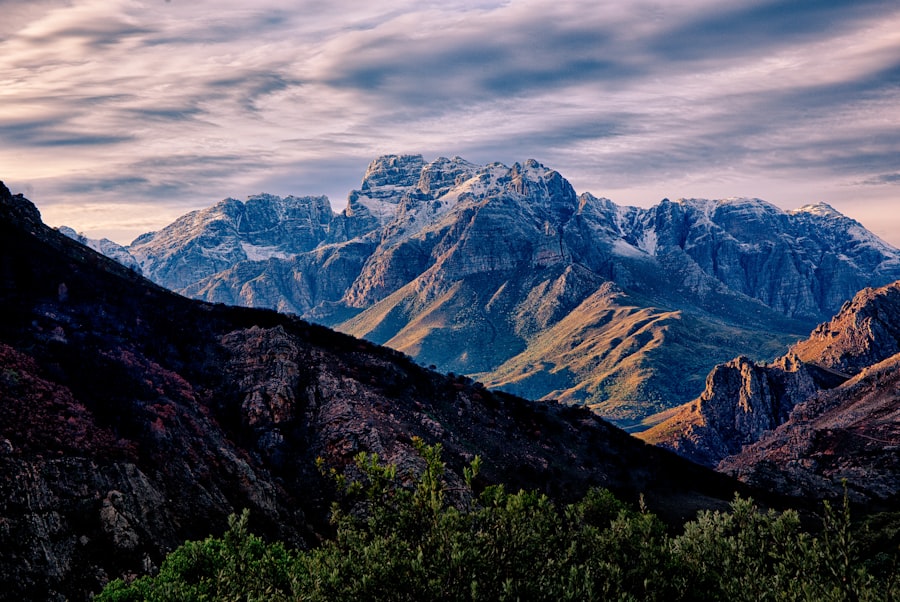Sri Lanka is home to a remarkable array of mountain ranges that contribute significantly to the island’s geographical diversity. The central highlands, often referred to as the “Hill Country,” are dominated by the towering peaks of the Knuckles Mountain Range and the Adam’s Peak, also known as Sri Pada. These mountains not only provide breathtaking vistas but also serve as vital watersheds for the surrounding regions.
The Knuckles Range, with its rugged terrain and rich biodiversity, is a UNESCO World Heritage Site, recognised for its unique flora and fauna. The peaks here rise dramatically, with some reaching altitudes of over 2,000 metres, creating a striking contrast to the low-lying coastal areas. The mountain ranges of Sri Lanka are not merely geological formations; they are steeped in cultural significance and history.
For centuries, these highlands have been a refuge for various communities, including the indigenous Veddah people and later settlers who sought the cooler climate and fertile soil for agriculture. The mountains are also interwoven with local legends and spiritual beliefs, particularly Adam’s Peak, which is revered by multiple religions, including Buddhism, Hinduism, and Islam. Pilgrims from all walks of life ascend this sacred mountain, especially during the pilgrimage season, creating a vibrant tapestry of cultural exchange and spiritual devotion.
Summary
- Sri Lanka is home to diverse mountain ranges, including the central highlands and the Knuckles Mountain Range.
- The lush valleys and plateaus of Sri Lanka, such as the Horton Plains and the Nuwara Eliya region, are known for their stunning natural beauty and rich biodiversity.
- The low-lying plains and coastal areas of Sri Lanka, including the Jaffna Peninsula and the Southern Coastal Belt, are important for agriculture and fishing industries.
- The varied terrain of Sri Lanka has a significant impact on its climate and biodiversity, with different regions supporting unique ecosystems and wildlife.
- Mountains, valleys, and plains have played a crucial role in shaping Sri Lankan culture and history, influencing everything from agriculture and trade to religious practices and folklore.
The Lush Valleys and Plateaus
Tea Plantations and Production
The rolling hills are adorned with meticulously manicured tea bushes, and the cool climate provides ideal conditions for tea cultivation. Visitors to Nuwara Eliya can witness the entire tea production process, from plucking the tender leaves to tasting the final brew.
Ecological Significance of the Valleys
The valleys of Sri Lanka are not only agriculturally significant but also ecologically rich. The Horton Plains National Park, located at an elevation of over 2,000 metres, is a prime example of a high-altitude plateau that harbours unique ecosystems. This park is home to endemic species such as the Sri Lankan sambar deer and the elusive purple-faced langur.
Conservation Efforts and Microclimates
The park’s famous “World’s End” cliff offers a dramatic drop and panoramic views that attract hikers and nature enthusiasts alike. The interplay between the valleys and plateaus creates microclimates that support diverse plant life, making these areas crucial for conservation efforts.
The Low-lying Plains and Coastal Areas

As one descends from the mountainous regions, the landscape transitions into expansive low-lying plains and coastal areas that define much of Sri Lanka’s geography. The northern plains are characterised by their flat terrain and fertile soil, which supports extensive agricultural activities. Rice paddies dominate the landscape, with farmers utilising traditional methods passed down through generations.
The abundance of water from rivers such as the Mahaweli facilitates irrigation, allowing for multiple cropping seasons throughout the year. The coastal areas of Sri Lanka are equally diverse, featuring sandy beaches, rocky shorelines, and vibrant coral reefs. The southern coast is particularly famous for its picturesque beaches like Unawatuna and Mirissa, which attract both local and international tourists seeking sun and surf.
These coastal ecosystems are vital for marine biodiversity, providing habitats for various species of fish, sea turtles, and other marine life. Additionally, the coastal regions are integral to the livelihoods of many communities engaged in fishing and tourism, highlighting the interconnectedness of geography and human activity.
The Impact of Terrain on Climate and Biodiversity
The varied terrain of Sri Lanka has a profound impact on its climate and biodiversity. The central highlands experience a cooler climate compared to the low-lying areas due to their elevation. This climatic variation creates distinct ecological zones that support a wide range of flora and fauna.
For instance, the wet zone in the southwest receives heavy rainfall, fostering lush rainforests that are home to endemic species such as the Sri Lankan elephant and leopard. In contrast, the dry zone in the north and east experiences less rainfall, resulting in scrub forests and grasslands that support different wildlife. The interplay between altitude and climate also influences agricultural practices across the island.
In the cooler highlands, crops such as tea, vegetables, and fruits thrive, while in the warmer lowlands, rice and spices dominate cultivation. This diversity in agricultural output is a direct result of the varying climatic conditions shaped by Sri Lanka’s topography. Furthermore, conservationists recognise that preserving these diverse ecosystems is crucial for maintaining biodiversity and ensuring sustainable agricultural practices.
The Role of Mountains, Valleys, and Plains in Sri Lankan Culture and History
The mountains, valleys, and plains of Sri Lanka have played an integral role in shaping the island’s culture and history. Historically, these geographical features provided natural fortifications for ancient kingdoms such as Anuradhapura and Polonnaruwa. The strategic location of these cities amidst mountains and rivers allowed them to flourish while offering protection from invasions.
Temples and stupas built in these regions reflect the architectural prowess of ancient Sri Lankan civilisations and their deep spiritual connection to the land. Culturally, these terrains have influenced local traditions and practices. For instance, in rural communities nestled in valleys, agriculture is often intertwined with festivals celebrating harvests and seasonal changes.
The annual paddy harvest festival known as “Pongal” showcases traditional rituals that honour nature’s bounty. Similarly, mountain communities have their own unique customs related to pilgrimage routes leading to sacred sites like Adam’s Peak. These cultural expressions highlight how deeply intertwined Sri Lankan identity is with its diverse landscapes.
The Challenges and Opportunities of Sri Lanka’s Varied Topography

Natural Disasters and Agricultural Productivity
Natural disasters such as landslides in mountainous regions can disrupt communities and threaten livelihoods. The heavy monsoon rains can lead to soil erosion and loss of arable land in hilly areas, impacting agricultural productivity.
Climate Change and Sustainable Development
Additionally, climate change exacerbates these challenges by altering rainfall patterns and increasing the frequency of extreme weather events. Conversely, Sri Lanka’s diverse terrain offers immense potential for sustainable development initiatives.
Ecotourism and Innovative Agricultural Techniques
The promotion of ecotourism in mountainous regions can provide economic benefits while encouraging conservation efforts. By showcasing the natural beauty of places like Horton Plains or the Knuckles Range, local communities can engage in sustainable practices that protect their environment while generating income through tourism. Furthermore, innovative agricultural techniques such as terracing can mitigate soil erosion in hilly areas while maximising crop yields.
Conservation Efforts in Sri Lanka’s Unique Terrain
Recognising the importance of preserving its unique terrain, Sri Lanka has implemented various conservation efforts aimed at protecting its rich biodiversity and ecosystems. National parks such as Yala and Udawalawe serve as sanctuaries for wildlife while promoting eco-friendly tourism practices. These protected areas not only safeguard endangered species but also provide educational opportunities for visitors to learn about conservation efforts.
Community-based conservation initiatives have also gained traction in recent years. Local organisations work alongside government agencies to promote sustainable land use practices that benefit both people and nature. For example, reforestation projects in degraded areas aim to restore native habitats while providing alternative livelihoods for local communities through agroforestry practices.
These collaborative efforts highlight the importance of involving local populations in conservation strategies to ensure long-term success.
Exploring Sri Lanka’s Terrain: Adventure and Ecotourism Opportunities
Sri Lanka’s diverse terrain offers a plethora of adventure and ecotourism opportunities that cater to nature enthusiasts and thrill-seekers alike. Hiking trails through mountainous regions provide breathtaking views while allowing visitors to immerse themselves in nature. The trek to Adam’s Peak is particularly popular among both locals and tourists who seek spiritual fulfilment or simply wish to experience the stunning sunrise from its summit.
In addition to hiking, activities such as birdwatching in wetlands or exploring coral reefs through snorkelling or diving attract ecotourists eager to witness Sri Lanka’s rich biodiversity firsthand. The country’s commitment to sustainable tourism ensures that these activities are conducted responsibly, minimising environmental impact while maximising visitor engagement with nature. As awareness grows regarding the importance of preserving these unique landscapes, more travellers are seeking experiences that connect them with Sri Lanka’s natural heritage while supporting local communities through responsible tourism practices.
FAQs
What is the terrain and topography of Sri Lanka like?
Sri Lanka’s terrain is diverse, with a mix of mountains, valleys, and plains. The central part of the country is dominated by mountainous terrain, while the coastal areas consist of plains and valleys.
What are the major mountain ranges in Sri Lanka?
The central highlands of Sri Lanka are home to several major mountain ranges, including the Knuckles Mountain Range, the Adam’s Peak Range, and the Horton Plains.
Are there any significant valleys in Sri Lanka?
Yes, Sri Lanka is home to several significant valleys, including the Kandy Valley, the Badulla Valley, and the Kotmale Valley. These valleys are known for their lush greenery and scenic beauty.
What are the plains like in Sri Lanka?
The coastal areas of Sri Lanka are characterized by plains that are relatively flat and fertile. These plains are important for agriculture and are home to many of the country’s major cities and towns.
How does the terrain and topography of Sri Lanka impact the country?
The diverse terrain and topography of Sri Lanka have a significant impact on the country’s climate, biodiversity, and agriculture. The mountains influence the weather patterns, while the plains are important for farming and urban development.


